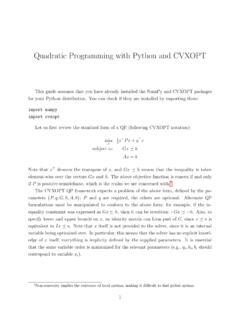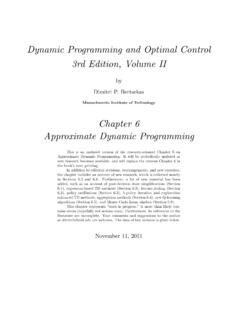Transcription of Siemens SIMATIC Step 7 Programmer's Handbook
1 7/26/12 Siemens SIMATIC step 7 Programmer's Handbook Siemens SIMATIC step 7 Programmer's Handbook This Handbook is a collection of programming overviews, notes, helps, cheat sheets and whatever that can help you (and me) program a Siemens PLC. If you have experience with Siemens then please contribute. Siemens Website Quick Links This is a listing of tutorials and manuals found on the Siemens automation website that will get you started on the SIMATIC step 7 software for S7-300 and S7-400 systems. From a new users perspective I've only heard disparaging comments about finding the right information on the Siemens ' website. I have to agree. Its information overload at it's best. There's a lot of different stuff there thrown together and found in different spots with very long URL addresses to add to the confusion. Have no fear. We're here to help. So we'll look at the essentials for your journey. The software if you haven't got it yet Getting a sense for the product line Where to start with the manuals Online training material Downloadable Flash tutorials Of course the best type of training is the hands on type but if that's not an option then you'll need to start 1/63.
2 7/26/12 Siemens SIMATIC step 7 Programmer's Handbook digging in. Who's got the Software? If you are just learning and can't easily get the software then there are two options. 1. Order the demo CD which will give you a free 30-day trial period. 2. Download a free working copy of step 7 Lite. There are differences between the regular version of step 7 and step 7 Lite but for learning purposes you can go along way with the free Lite version. First Things First The first thing I like to do with a new product is get an overview of everything. Getting used to part numbers and product groupings can go a long way with your comfort level. The best thing for this is the sales catalog (ST 70 2005). You can also order a hard copy. Where to Start? Manuals, manuals, everywhere! Once you install the step 7 software there will be a directory under the SIMATIC folder called Documentation that includes the most important manuals.
3 Hard copies can be ordered with number 6ES7810-4CA08-8BW1. Here's how I would digest them. 1. Working with step 7 - This is a basic introduction to step 7 which walks through an example of controlling engines. While it's not the complete picture it does ease you very well into the learning curve of the step 7 software. 2. programming with step 7 Manual - Here's the fuller manual for the programming interface which is also the same as the online help accessed by pressed the F1 key. 3. Configuring Hardware and Communication Connections step 7 Manual - Everything to do with the Hardware Configurator. 4. Statement List, Ladder Logic, and Function Block Diagram Reference Manuals - These manuals contain both the user's guide and the reference description of the programming language or representation type. You only require one language type for programming an S7-300/S7-400, but you can mix the languages within a project, if required.
4 If you're more comfortable with Ladder Logic or Function Block Diagram then start there but sooner or later you'll have to become familiar with Statement List. 5. System Software for S7-300 and S7-400 System and Standard Functions Reference Manual - The S7 CPUs have integrated system functions and organization blocks included with their operating system, which you can use when programming . This manual provides you with an overview of the system functions, organization blocks, and loadable standard functions available in S7, and detailed interface descriptions for their use in your programs. Training Material There's gold in that website if you just do a little digging! If you're having a tough go with the manuals then you should definitely download the training material. There's a lot more screen shots and even a picture of a balding pudgy guy to point things out to you. What more could you want? Flash Tutorials 2/63.
5 7/26/12 Siemens SIMATIC step 7 Programmer's Handbook If you're not the manual type (and even if you are) check out the Siemens step 7 Flash tutorials. These are very professionally done with a nice sounding narrator to take you through all the basics of the step 7. software and hardware. What's Next? Of all the starting places to dig for more info I find the support section the best especially if you have a part number or key word you can search on. Clicking on the Product Support link will bring up a tree on the left hand side that can be expanded down to the product of your affection. Good luck and happy hunting. 3/63. 7/26/12 Siemens SIMATIC step 7 Programmer's Handbook Review of Siemens SIMATIC step 7 Lite programming Software Great taste. Less filling.. When one hears the words Lite and software you tend to think of software that's not really usable. Depending on your needs this may not be the case with the Siemens step .
6 7 Lite package. The four major limitations in step 7 Lite verses the more advanced step 7 package are: 1. Support limited to the SIMATIC S7-300 PLC, the C7 all-in-one PLC and HMI, and the intelligent CPUs of the ET200 distributed I/O family. So no programming for the S7-200 or S7-400 PLC series. 2. No networking whatsoever. Remote I/O racks (IM modules) are supported but there's nothing for Profibus DP even if you have a DP port on your CPU. 3. No support for multi-projects or HMI integration. 4. No communication processors (CP) or function modules (FM) supported. If you're interested in more details then refer to our chart of differences between the step 7 program packages. So there are quite a few major limitations with the step 7 Lite software which may end your further reading of this review. On the other hand, the current availability of a free download of the SIMATIC step 7 Lite software makes it awfully tempting to take a look at it.
7 If your only use of Siemens PLCs are an S7-300, C7 or ET200 in a stand alone application with no special needs (CP or FM) then I could highly recommend the Lite package. It has the same level of programming functionality as the regular step 7 packages plus some nifty interface enhancements to make it easier on the eyes and on the brain. It is possible (though not easy) to convert any software created in the step 7 Lite to step 7 and visa versa keeping in mind the limitations of the Lite version. Since the packages bear a lot of similarities it will also be easy for the student to transfer any learning on the Lite package over to step 7. First Impressions For a user of the regular step 7 software the first thing to notice is there is no SIMATIC Manager. That's because the Lite version doesn't support multi-projects or networking. The step 7 Lite software opens right up to the editor screen. 4/63. 7/26/12 Siemens SIMATIC step 7 Programmer's Handbook The overall aim of the Lite package was to make the interface easier for new users.
8 I think they've done that while making it friendlier for everyone involved. The added graphics and color are a welcome addition. Another nice friendly feature is the extended hover help on the menus and icons where clicking on the tool tip expands it into more help text. On that note all the pop up dialogs are clearer then its step 7. counterpart. One of the major differences can be seen on the left hand side window. Pretty much everything the programmer needs for maintaining the project is neatly organized here. There's even a convenient thumb tack to pin it or make it automatically slide in and out when needed. On the right hand side is the old familiar tree structure of commands and blocks. It's missing the quick little reference help window on the bottom which has been replaced by just hovering your mouse over the command to get a fuller title (the F1 key works just the same too). The FC and FB blocks have been moved from here to a more logical place in the project window on the left hand side.
9 The Left Side Bar CPU Overview and Project Window The top portion introduces a CPU box with easy access to controls, diagnostics (Ctrl+D) and setup of the CPU. That's not something I feel is necessary to be there all the time so I minimized it. Too bad there's no apparent way to just get rid of it all together. The Project Window below it is great. Everything's is here from hardware to documentation. Something that just thrilled me is the tabs below that separate the offline and online versions of the program. On the regular step 7 software there is often a confusion between when you are offline or online. step 7 Lite minimizes that confusion by also provided clearly differentiated color schemes for when you have a block open online. And if that wasn't all, the symbols beside the hardware and each block instantly tell you of differences between the offline and online versions of your program. You can just hover the mouse over the symbol to get more detail.
10 5/63. 7/26/12 Siemens SIMATIC step 7 Programmer's Handbook It's also nice to have all the blocks clearly color coded and nicely arranged. You can drag and drop then anywhere in the list. There's even a new feature of Category which is simply an organizational label inserted between blocks. In this screen I've inserted the category Engine Data and Special Data . This could be really helpful for logically grouping blocks in larger projects. I also like the new way of creating blocks. From the pull down menu select Insert | Block and this nifty dialog box pops up with all the selections on it. Even the OB selection has a nice drop down box of all the OBs available with its symbolic name. The Hardware Manager The greatest change of all is the overhauled hardware manager. The layout is great and is to be expected without the need to factor in networking. Just drag and drop your hardware on the picture and away you go.



